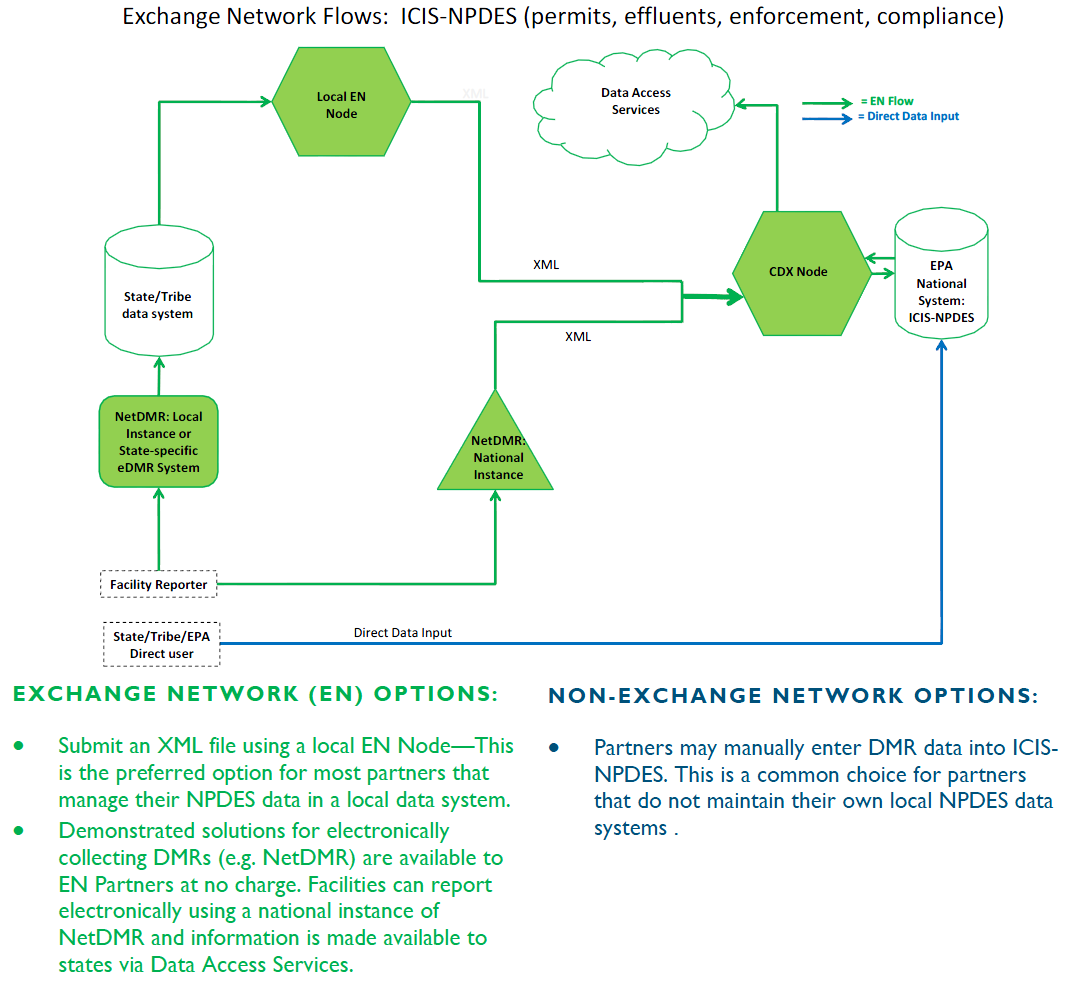Practical Implementation Advice
- As of December 10, 2012, ICIS-NPDES Exchange Network data flow is available for any interested State or Tribal Partners with primacy for the National Pollutant Discharge Elimination System (NPDES) program to submit their data to EPA’s ICIS-NPDES system electronically.
- The ICIS-NPDES Exchange Network data flow accepts XML files containing NPDES data for permit, inspection, enforcement, effluent discharge monitoring report (DMR), and special regulatory program report data.
- State and Tribal Partners who do not already have electronic systems for collecting effluent DMRs from their regulated community should consider implementing a demonstrated electronic DMR solution or using the National Installation of NetDMR.
ICIS-NPDES Data Flow Options
The figure shows the current options for flowing permit, inspection, and DMR data to ICIS-NPDES. Exchange Network (EN) flow options are shown in green and the direct data input option is shown in blue. No other data exchange options are available for ICIS-NPDES.
Summary of Current Practice
The ICIS-NPDES data flows are now available for all data families including permits, inspections, effluent, enforcement, and program reports. Partners with their own local NPDES system can use their Exchange Network Node to submit this information to EPA. EPA currently provides an outbound service that allows States to access permit requirements data so that it can be used to support local instances of electronic DMR reporting systems such as NetDMR.
The OpenNode2 full batch plugins provide Partners using .NET or Java OpenNode2 with software tools to simplify the submission of data from the Partner’s NPDES information system to EPA’s ICIS-NPDES system and to download, process, and distribute ICIS transaction processing reports. Download the ICIS-NPDES plugins and documentation here.
Terms
Node: A Partner’s point of presence on the EN consisting of a server (hardware and software) enabled with web services that allow Partners to automatically provide and receive information via the Network and to publish data for use by other Partners.
Node Client: A stand-alone application (i.e., software code) that lets Partners share data, request data, and receive results from an EN request. Clients differ from nodes in that they cannot respond to queries from other nodes and so cannot publish data. Clients also need more manual (rather than automated) steps, for example, to extract data and generate and review reports before submission.
EN Services Center: A website that allows Partners to easily send, get, and download information from other Partners. The Services Center will serve as a replacement for manual submissions of information through CDX Web. It is an appropriate solution for those Partners who do not require or are not yet ready for the automation and data publishing capabilities of an EN Node. The EN Services Center is available at https://enservices.epa.gov.
CDX: EPA’s Central Data Exchange. It serves as EPA’s centralized electronic report receiving system. It receives data from Partners and directs the data to EPA’s program-specific National Systems (e.g., AQS, WQX, etc.).
CDX Node: CDX Node is EPA’s node on the Network, allowing EPA to receive, send, and provide information via the Network. CDX Node can also publish EPA data for use by other Partners.
CDX Web (non-EN) Application: A legacy CDX application that receives data (flat file or XML format) via standard web browsers. CDX Web applications are not consistent with EN protocols (e.g., they have a separate authentication and authorization service from the EN) and typically involve more manual steps than a node-to-node exchange of data.
Data Access Services: Using web services to make data available to Partners by querying nodes and returning environmental data in the form of XML documents. Published data can be accessed using a node or clients. Published data can be used in a number of ways, such as populating Web pages, synchronizing data between sites, viewing data in a Web service client, or building new sources of data into an integrated application.
Direct User: A Partner entering data directly into a National Data System through a system-specific interface (manual entry).
EPA National Data System: Program-specific data systems at EPA that can receive and publish data..
Local Data System: A Partner’s database or series of databases in which environmental data are stored, managed, and manipulated.
XML: eXtensible Markup Language is a flexible language for creating common information formats and sharing both the format and content of data over the Internet and elsewhere. The electronic language that expresses and transports data standards and transaction sets. XML uses an extensible set of tags to describe the meaning of data.
Contact
Alison Kittle
U.S. Environmental Protection Agency
kittle.alison [at] epa.gov
202.564.6233

